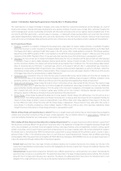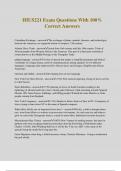Governance of Security
Lecture 1: Introduction. Exploring the governance of security (Dr.ir. V. Niculescu-Dinca)
The overall objective is to deepen knowledge of strategies, actors, levels and dilemmas in governing contemporary security challenges. As a result of
broad societal changes, influential technological developments and a growing complexity of security issues, amongst others, authorities throughout the
world increasingly govern security in partnerships and networks with other public and private actors at local, regional, national and global levels. On the
one hand, this shift offers opportunities — and some argue it is necessary — in dealing with complex security problems, such as terrorism, that cannot be
easily tackled independently by traditional state actors such as the national police. On the other hand, this multi-actor, multi-level mode of governance
comes with its own set of challenges. Safety and Security and the notion of Governance; what are the problems and who is dealing with those problems?
Set of insecurities and threats:
1. Pandemics: a pandemic is an epidemic of disease that has spread across a large region, for instance multiple continents, or worldwide. Throughout
history, there have been a number of pandemics of diseases (smallpox & tuberculosis) One of the most devastating pandemics was the Black Death
(The Plague), which killed an estimated 75–200 million people in the 14th century. Other notable pandemics include the 1918 influenza pandemic
(Spanish flu) and the 2009 flu pandemic (H1N1). Current pandemics is the 2019–20 coronavirus pandemic. Question 1: What are some of the security
implications of this COVID-19 pandemic? Even if it may seem early, what insecurities do you think will dominate in a post-pandemic world?
2. Cyberspace: the more our lives rely on complex technological infrastructures, the more our interactions with the state and with each other take place
in cyberspace. Viruses can also be digital. Cyberspace deserves special attention, because of several concepts. First of all, it is global and provides
real time connections; therefore, time, distance and national borders are less important than in traditional crime. The internet being a digital network,
allows for processing data and information in automated ways, almost in at the speed of light and often in unprecedented ways. Insecurities in
cyberspace are a long standing problem for governments, cities, companies, private and public organisations, as well as for individuals. Cybercrime,
cyberbullying and cyber-warfare are different complex problems. There consequences are also wide-ranged. Question 2: What do you think are some
of the biggest insecurities of our growing reliance on digital infrastructures?
3. Transnational crime: transnational crimes are crimes that have actual or potential effect across national borders and crimes that are intrastate but
offend fundamental values of the international community. Examples include human trafficking, drugs and weapons' trafficking, contraband, money
laundering, extortion, etc. Question 3: What do you think are some of the upcoming trends regarding these threats and insecurities?
4. Gangs and youth delinquency: Gangs increase the levels of crimes in communities, and set a bad example for kids in the area. They create an image
of power and respect, when in reality they drop out of school, struggle with unemployment, abuse drugs and alcohol or end up in jail. Additionally,
gang membership intensifies delinquent behaviour. From the earliest to the most recent investigations, criminologists have consistently found that,
when compared with youth who do not belong to gangs, gang members are far more involved in delinquency, especially serious and violent
delinquency. Question 4: What do you think about the security implications of this phenomenon?
5. Climate Change: climate change has replaced the global war of nuclear weapons. Climate Change is the defining issue of our time and we are at a
defining moment. From shifting weather patterns that threaten food production, to rising sea levels that increase the risk of catastrophic flooding, the
impacts of climate change are global in scope and unprecedented in scale. Without drastic action today, adapting to these impacts in the future will
be more difficult and costly. A threat that comes with this climate change, is displacement. They are forced to move, either within their country or
across borders. It is therefore considered as a threat multiplier. Question 5: What do you think are some of the insecurities multiplied by climate
change? How do you think policies on climate change will evolve in a post-pandemic world?
What do all these threats and insecurities have in common? There are no straight answers and solutions, they are interconnected, they are shaped by
complex social and political constraints and they all require complex approaches. They are therefore referred to as wicked problems: challenges that
cannot be handled by dividing them up in simple pieces in mere isolation from each other.
Who is dealing with these threats and insecurities (who is dealing with governance)? Can we speak of governance without referring to a government?
Yes! Governance is obviously different from government. Governance refers to the deployment of multiple forms of regulation (processes through which
norms, rules and programs are monitored, forced and adapted involving a wide range of policies, actors and stakeholders, involved in solving a specific
problem or providing a common good. However, government and governance do not occupy in separate realms. We can best understand this overlap in
the domestic level vs. international level. Within the domestic level, a government is a group of people with the authority to govern a country or state; a
particular ministry in office. In the international arena, there is no such thing as an overarching government. However, there are different governments
working together. When these governments work together with NGO’s (Red Cross, Greenpeace, World Wildlife Fund, etc.) we can speak of governance. It
is about the enhancement through collective effort of international regulation.
- Domestic level: government has a clear legal normative and physical existence, but its existence has become more complex over time due to the
outsourcing of responsibilities to private bodies. Governors often delegated by the functions of government. However, the traditional influences of the
government still exist.
- International level: the government and governors’ distinction here is different; government as a central authority is not a absent. Internationally, the
government does not exist as an overarching form. The government plural does in the shape of states projecting national authority. Their interaction
along with that of non-state actors that gives rise to governors. The absence of a global government means that at the international level no such
delegation from a single authority can occur thus we see the exercise of governance without government.
1
,Governance: Governance as aggregation of behaviours: processes (governance is the complex interaction of processes among actors and the bottling
together of these actions in service of their goals) vs singular action & serving broader purposes (governance provides solutions to society as a whole).
What does the governance perspective contribute? Governance as a particular way of seeing the world: focusing on complex wicked issues & involving
international organisation, sovereign states as well as other non-state actors. To promote effectiveness, legitimacy and accountability. The role of formal
governments: as an important actor, operating on many levels to address safety and security & connected in networks (relations with other actors). A
governance approach does not mean that a government is left out of this equation. A formal government is acknowledged as one of the important actors.
Shifts in style of governing: negotiation and accommodation (how do actors manage to compromise between their own interests and priorities and the
common problem they aim to solve) & concentration and cooperation (how do actors manage to set arrangements/alliances/networks in order to
collectively address security challenges).
Hierarchies, centralisation and control are the whole modes of government; however, governance is captured by a proliferation of modes of
organisation, levels and decision-making authorities. Governance entails a fundamental shift in location of exercise of power, at the same time it also
provides a shift in style of governing from hierarchical top-down command and control by a central government and the interactions between various
government networks.
What is governance of security about? The complexity of security challenges has brought about an expansion of the types and numbers of the actors
involved. States always played an important role in delivering security such as by an alliance or set up security organisation. Non-state actors also
increasingly have become involved. Two trends highlighted here are: 1) intergovernmental relations and 2) the greater rule played by non-state actors in
security provision.
1. Trend 1: intergovernmentalism can be seen at the global (UN, UNSC, UNGGE failure in 2017 to agree on consensus report about norms in cyber
space), regional and interregional levels (regional organisations taking more prominent roles; NATO from Cold War occupation to incorporate
different tasks such as crisis management or corporative security, terrorism, cyberattacks It diversified its capabilities).
2. Trend 2: privatisation of security (private security actors) (private military companies (PMCs) and private security companies (PSCs), commercial private
security & pluralisation of policing).
Summary: there is a multiplicity of actors, state shifted from a security provider to an enabler/employer/regulator (to private actors), complex networks of
security of governance, private security, blurring of the internal and the global aspects of security due to private actors. How do you think governance of
security will look like in a post-pandemic world? State and non-state actors (e.g. Philips and Dutch government working together) will continue in
strengthening their cooperation in security governance & this crisis will induce on state behaviour in making them getting better prepared in anticipation
in next similar crises. This shows that the state is the main actor as a security provider by increasing security measures.
Lecture 2: Understanding governance of security (Dr.ir. V. Niculescu-Dinca)
Governance decisions are made in complex networks and compassing national, supranational subnational actors either public or private. At the same
time, sovereign state has configurated as one in a broader more diverse network of power. Security networks and wicked problems: Wicked problems
tend to elicit network responses; need to be highly adaptive. Wicked problems can be unknown, inconsistent or frequently changing; necessitating a
coordinated response is needed. We are shifting from understanding to doing governance of security.
Security Network examples:
- The North Atlantic Treaty Organisation (NATO): an intergovernmental military alliance between 30 North American and European countries. The
organisation implements the North Atlantic Treaty that was signed on 4 April 1949. NATO constitutes a system of collective defence whereby its
independent member states agree to mutual defence in response to an attack by any external party. NATO can currently be best characterised as a
complex security network rather than a traditional alliance focused on a common enemy.
- Radicalisation Awareness Network (RAN): Fighting terrorism and violent extremism involves more than surveillance and security. The Radicalisation
Awareness Network (RAN) brings together practitioners from around Europe working on the prevention of radicalisation. Practitioners include police
and prison authorities, but also those who are not traditionally involved in counter-terrorism activities, such as teachers, youth workers, civil society
representatives, local authorities representatives and healthcare professionals. Additionally a research platform. Local in approach, but global in scope.
- Safety Houses: Networks of organisations working together to fight criminality by a multi actor approach. A safe house is, in a generic sense, a secret
place for sanctuary or suitable to hide persons from the law, hostile actors or actions, or from retribution, threats or perceived danger. Their actions
range from care to sanctions.
- Neighbourhood watch: an organised group of civilians devoted to crime and vandalism prevention within a neighborhood. The aim of neighbourhood
watch includes educating residents of a community on security and safety and achieving safe and secure neighbourhoods. Also through WhatsApp.
Networks and network analysis: The two definitions are related. Although this lecture we mainly concentrate on the second definition, the study of
networks can certainly benefit social network analysis.
1. Network analysis as a method: social network analysis is a set of analytical tools used for social and behavioural sciences which investigates social
structures through the networks and graph theory. With such tools, social network analysis can visualise phenomenon such as information circulation,
business networks, terrorist networks and social networks.
2
, 2. Networks as mode of governance: the network concept here is used to refer to organisational configurations in which a multitude of actors, ranging
from individuals, organisations and so on, constitute the notes while the ties could be various formal exchange relations.
So, what are networks? ”structures of interdependence involving multiple organisations or parts thereof, where one unit is not merely the formal
subordinate of the others in some larger hierarchical arrangement” (O’Tool, 1997, Treating networks seriously) or “a group of three or more organisations
connected in ways that facilitate achievement of a common goal’ (Provan, Fish and Sydow, 2007, Inter-organisational networks). There is a Distinction with
inter-organisational relations: collaboration or contracting can occur in networks, but their presence does not necessarily make a network, even if
collaboration is critical to the success of a network, dyadic inter-organisational collaborations do not necessarily make a network. So, what are security
networks? ”a set of institutional, organisational, communal or individual agents or nodes that are interconnected in order to authorise and/or provide
security to the benefit of internal or external stakeholders” (Dupont, 2004, Security in the Age of Networks). He also provides a typology of security
networks, local, institutional, international and informational or technological. With this definition and typology, he calls for the development of a common
conceptual platform to interpret the complexification of security provision, across a whole spectrum of configurations that could reach the gap between
state-centric and pluralist views on security. Another scholar who wrote extensively on security networks is Whelan (2012). He defines security networks
as ”a network in which a set of ‘actors’ (or nodes) have formed ‘relationships’ (or ties) to advance security-related objectives”. In his conception, actors (or
nodes) can represent individuals, groups, organisations or any other entity. Ties or relationships are what connect the nodes. Can be formal (legal, or any
other kind of other organisational arrangement) or informal (depending on the strength of interpersonal trust and relationships). When a definition is
specific, it provides clarity and precision in identifying actors and relations; however, it also becomes more rigid, potentially missing new phenomenon and
might go towards being outdated. On the other hand, when a definition aims to be general and broader in scope, it loses its specificity and can lead to
vagueness and confusion. It is said that “large nodes – such as Interpol or EUROPOL – can become networks in their own right” (Whelan, 2012). Important
to set explicit boundaries in defining nodes to avoid confusing interpretations.
Remarks on Elke Krahmann’s article (2005): Relation between security governance and networks: she uses the definition of security networks as ”sets of
actors that share an interest in a specific issue area and are linked to each other through stable formal or informal relations”. She proceeds to explain the
relation to security governance: “The literature on global and security governance largely seeks to describe and analyse historical and institutional change
in international relations and its consequences”. She therefore states that ”The concept of security governance might best be employed as a theory for
the explanation of the transformation from ‘government’ to ‘governance’” . At the same time, emergence of security governance contributes to explain
the proliferation of networks as a mode of coordination. In short, while global and security governance has mainly been concerned with the transformation
of security policy making, the notion of networks have been predominantly applied to understanding the relations and interactions within and between
public and private organisations at different levels. Use of the terms networks and network analysis: the author argues that “network analysis is primarily
been concerned with questions such as: Who are the most powerful or central actors within particular governance arrangements? How do relations
between actors influence their interactions? How are network structures related to particular outcomes?” Network analysis offers insights into the structure
and function of control and coordination arrangements that make up security governance. To conclude, when attempting to analyse security provision
arrangements, it is useful to understand the relation between security governance networks, to employ, discuss and problematise various definitions of
security networks with the emphasise and with the limitations and to distinguish between various conceptions between the overloaded term of network.
Why security networks?
I. Ontological: a reality needs to be accounted for
II. Epistemological: we do not know much about them
III. Ethical: legitimacy and accountability can be low
IV. Policy: they tend to be preferred by policy makers
The pluralisation of policing: Generally the new forms of policing concentrate on the surveillance and
control of petty crime and social disorder in public places. The sovereign state has reconfigured as one
node in a broader, more diverse network of power. The institutions of the sovereign state remain critical
in security provision through national police forces, transforce police units or policing services provided
directly by local authorities. Policing above government includes police level arrangements above the
sovereign state (e.g. EUROPOL). Policing below government is done through involved citizens (e.g.
neighbourhood watch). Policing beyond government describes the commercial market (e.g. cameras).
What are the reasons for the rise of security networks?
Global Financial Policy Technological Local
End of Cold War and the Limited resources (due to, Limited resources, lack of Rise of the internet High levels of crime and
rise of new security threats e.g., financial crisis of ‘70s) expertise disorder
More pervasive, probable Budget cuts (‘divestment of Delegation of functions -> Collapse of all sorts of Feelings of insecurity
and able to cross borders the welfare state’) regional, global barriers
Requiring collaboration and High expenditure (due to, Disperced resources, actors New possibilities to Lack of resources
concentration e.g. complex security have to coordinate establish all kinds of ties
threats)
3






